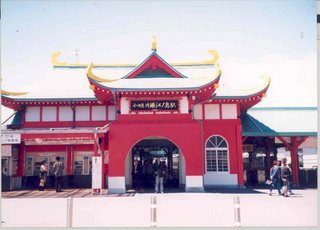Kabuki, No and Bunraku
Kabuki ->
Kabuki (歌舞伎) is a traditional Japanese form of theater with its origins in the Edo period.Kabuki plays are about historical events, moral conflicts in love relationships and the like. The actors use an old fashioned language which is difficult to understand even for some Japanese people. They speak in a monotonous voice and are accompanied by traditional Japanese Instruments.The kabuki stage (歌舞伎の舞台) is a rotating stage and is further equipped with several gadgets like trapdoors through which the actors can appear and disappear. Another specialty of the kabuki stage is a footbridge (花道) that leads through the audience.The actors are all men who are specialized in playing female roles (女形). During kabuki plays, it is common for fans in the audience to shout the name of their favorite actor just in the right moment during short pauses.
No ->
"No" (能) is a very old form of traditional Japanese theater with its origins in the 14th century. The actors of "No" plays wear masks. They speak and sing in a very monotonous way, accompanied by a chorus and traditional music instruments. The "No" stage is usually located outdoors.In "No" plays too the actors are all men, who play the roles of beautiful women, villains, and heroes.
Bunraku ->
Bunraku (文楽) is traditional Japanese puppet theater that has its origin in the Edo period. Bunraku and Kabuki are closely related with respect to the content of plays. Bunraku plays are also accompanied by the music of traditional Japanese music instruments.The puppets are about one meter tall and are manipulated by up to three persons. Every person is responsible for a different part of the puppet.
Kabuki (歌舞伎) is a traditional Japanese form of theater with its origins in the Edo period.Kabuki plays are about historical events, moral conflicts in love relationships and the like. The actors use an old fashioned language which is difficult to understand even for some Japanese people. They speak in a monotonous voice and are accompanied by traditional Japanese Instruments.The kabuki stage (歌舞伎の舞台) is a rotating stage and is further equipped with several gadgets like trapdoors through which the actors can appear and disappear. Another specialty of the kabuki stage is a footbridge (花道) that leads through the audience.The actors are all men who are specialized in playing female roles (女形). During kabuki plays, it is common for fans in the audience to shout the name of their favorite actor just in the right moment during short pauses.
No ->
"No" (能) is a very old form of traditional Japanese theater with its origins in the 14th century. The actors of "No" plays wear masks. They speak and sing in a very monotonous way, accompanied by a chorus and traditional music instruments. The "No" stage is usually located outdoors.In "No" plays too the actors are all men, who play the roles of beautiful women, villains, and heroes.
Bunraku ->
Bunraku (文楽) is traditional Japanese puppet theater that has its origin in the Edo period. Bunraku and Kabuki are closely related with respect to the content of plays. Bunraku plays are also accompanied by the music of traditional Japanese music instruments.The puppets are about one meter tall and are manipulated by up to three persons. Every person is responsible for a different part of the puppet.


